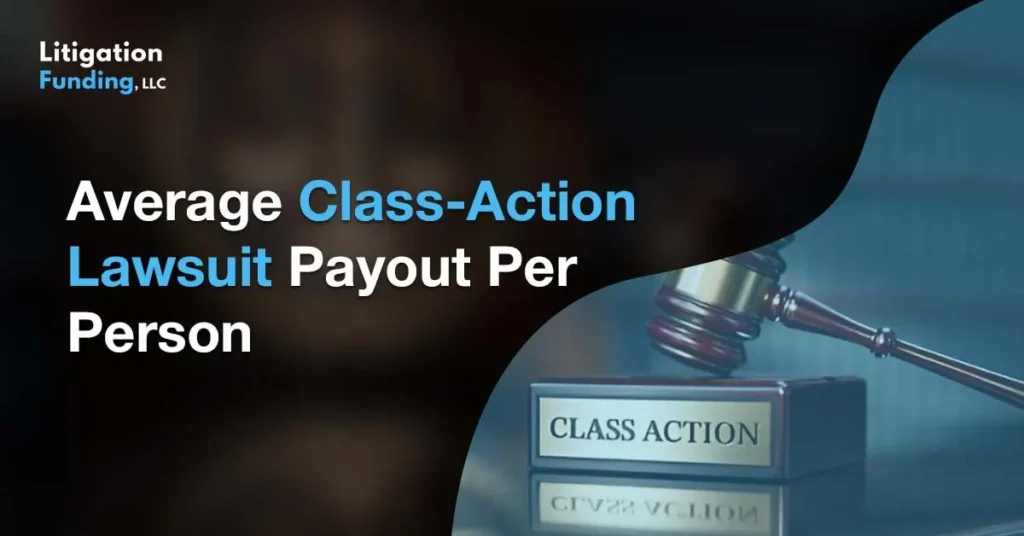When a settlement notice lands in your mailbox or inbox, the first question that comes to mind is almost always about the payout. The answer is rarely simple. Each case follows its own path, which means no single figure works as an average for everyone involved. For some, the check is barely enough to buy a coffee, while for others, the amount can climb into the thousands and bring real financial relief.
In the sections below, you will see how settlement funds are divided, what influences the final share, and how past cases turned out. With that knowledge, it becomes easy to set realistic expectations and make better financial choices while waiting for payment.
Why There Is No Fixed Average Payout
Class action lawsuits operate differently from individual personal injury or civil cases. Instead of damages being tailored to one person’s losses, a single settlement fund is divided among thousands or even millions of people. That distribution means that no reliable average applies across the board.
Each case has its own dynamics. The size of the settlement fund, the severity of the harm caused, and the number of participants all affect the distribution. A smaller class with higher documented damages might receive substantial checks, while massive consumer cases may yield symbolic payouts that barely reach double digits.
Typical Low-End Payouts in Consumer Cases
Consumer class actions often focus on issues such as misleading advertising, defective household products, or breaches of data privacy. These lawsuits typically attract a very large number of claimants, sometimes numbering in the millions. Once attorney fees and administrative costs are deducted, the remaining funds are spread thin across the participants.
In many consumer settlements, the final payout ranges between ten and fifty dollars per claimant. Several factors explain why these amounts are often modest.
- The claimant pool is usually overwhelming in size, which reduces the share each person receives.
- Attorney fees and administrative expenses are deducted before the settlement is divided, leaving a smaller pool for claimants.
- Individual damages are relatively minor compared to the overall case value, which further limits what each participant takes home.
For those depending on these payouts, the waiting period can be discouraging. When financial pressure increases, pre-settlement funding may serve as a helpful option by allowing access to a portion of the expected payout ahead of time. Companies such as Litigation Funding LLC provide this support through non-recourse funding that is only repaid if the case ends successfully.
When Payouts Are Higher
Not all class actions end with small checks. Certain lawsuits produce much larger payouts for individuals, particularly when damages are serious and the number of eligible claimants is limited. Health-related harms, environmental issues, or large-scale corporate misconduct often generate settlements that deliver meaningful compensation.
For example, in the Volkswagen emissions settlement, eligible car owners received amounts ranging from $5,100 to $10,000 each. In another case, the Juul settlement provided qualifying claimants with payouts of up to $9,000 per person.
These cases show that the nature of the wrongdoing and the scale of damage directly influence how much participants ultimately receive.
Real-World Examples Show the Variance
Looking at recent settlements helps illustrate the wide range of possible outcomes.
- Apple Siri Data Settlement – Some claimants collected less than one dollar.
- Mastercard UK Settlement – The average payout was about $2.27 per person, capped at $45.
- Facebook Biometric Privacy Settlement – Claimants received an average of $397 each.
These examples show just how unpredictable class action payouts can be, with results ranging from symbolic checks to meaningful compensation. Some are little more than symbolic acknowledgments of wrongdoing, while others can make a tangible financial impact.
Factors That Impact Your Payout
The size of your settlement check is rarely random. Several underlying components shape the distribution, and knowing them helps set realistic expectations.
Total Settlement Fund
The overall size of the settlement fund determines the pool of money available. Larger funds can allow for higher payments, but the final share still depends on how many people are included in the class.
Number of Claimants
When many individuals are part of the lawsuit, the available money must be divided into smaller portions. A larger claimant pool usually leads to smaller individual checks.
Attorney and Administrative Deductions
Legal fees and administrative costs are deducted before distribution begins. These necessary expenses reduce the amount left for claimants but ensure the process runs smoothly.
Lead Plaintiff Awards
Those who take on the role of lead plaintiffs often receive additional compensation for their time and effort. This special award slightly reduces the pool available for other participants.
When all of these factors are combined, they explain why some payouts end up modest while others are more meaningful. For participants facing financial strain during the wait, pre-settlement funding can provide early access to a portion of the expected compensation.
How Payouts Are Determined
The formula behind class action distribution is structured but often disappointing to individuals hoping for large sums. The process typically follows this sequence:
- Establishment of the total settlement fund.
- Deduction of attorney fees, court costs, and administrative expenses.
- Division of the remaining balance among approved claimants.
- Court-appointed administrators issue payments by check or direct deposit.
This sequence ensures fairness in theory, yet the mathematics usually reduces individual payouts to far less than expected.
Timeline for Receiving Class-Action Settlement Payouts
Receiving a class-action settlement payout often takes time. Even after approval, months or even years may pass before checks are issued.
Delays usually occur because the court must approve the settlement plan, administrators must process and verify claims, and any appeals can stall distribution further.
In most cases, payments are completed within six months to several years. While waiting, many people still face daily expenses, making pre-settlement funding a helpful option. Since this funding is non-recourse, repayment is only required if the case is successful.
Pre-Settlement Funding as a Helpful Option
Being part of a class action does not guarantee swift financial relief. While the legal process unfolds, people must continue managing daily life and its obligations. This is where class action pre-settlement funding becomes relevant.
Funding providers like Litigation Funding LLC offer advances against expected settlements. The most important detail is that repayment is only required if the case concludes successfully. That means there is no risk of debt if the lawsuit does not result in payment. For many families, this bridge funding alleviates financial stress and provides breathing room during lengthy legal proceedings.
What You Can Do Now
If you have received a notice about a class action settlement, start by reviewing the documents thoroughly so you understand your eligibility and the terms of the agreement. Pay close attention to deadlines and make sure your claim is submitted on time, since missing the filing date can prevent you from receiving any payout.
While waiting for compensation, it helps to stay in regular contact with your attorney to remain updated on the progress of the case. If legal delays are creating financial stress, apply for pre-settlement funding today and get fast cash within 24 hours, no lengthy paperwork or credit checks required.
Get the Financial Support You Need During Your Class Action Case
Litigation Funding LLC provides pre-settlement funding for a wide range of cases, including:
- Personal Injury Lawsuits – Cover your expenses while waiting for a personal injury settlement.
- Car Accident Funding – Get quick cash to manage repairs, medical bills, and daily costs.
- Employment Lawsuit Funding – Stay financially stable during wrongful termination or wage dispute cases.
- Nursing Home Abuse – Access funds while major corporate cases move through court.
Each funding option is non-recourse, meaning you only repay if you win. If legal delays are putting pressure on your finances, apply for pre-settlement funding or contact our team to discuss your case today. Most approvals are completed within 24 hours—no lengthy paperwork or credit checks required.
Final Thoughts
Class action lawsuits remain a powerful mechanism for holding corporations accountable and providing collective justice. Yet the distribution of settlement funds is rarely straightforward. Some payouts offer life-changing relief, while others barely cover a cup of coffee.
If you are waiting for your class action payout and financial obligations are piling up, Litigation Finding LLC offers trusted support through pre-settlement funding. This kind of support can make the difference between financial strain and stability while you wait for your case to finally resolve.
Frequently Asked Questions
What is the average class action payout per person?
There is no fixed average. Some settlements result in less than five dollars, while others exceed several thousand dollars. The size of the fund, the class size, and the severity of damages all determine the outcome.
Why are some settlements only a few dollars per person?
In cases with millions of claimants and significant attorney deductions, the remaining funds are divided into very small shares. This often leaves participants with symbolic checks rather than meaningful compensation.
Are payouts the same for every member?
Not necessarily. Lead plaintiffs often receive larger awards, and in certain cases, participants with documented damages may qualify for higher payments. Most members, however, receive identical amounts once expenses are deducted.
What if I have not received my check yet?
Delays are common. Administrative reviews, appeals, and distribution planning can postpone checks for months or years. If you have concerns, contact the settlement administrator and consider pre-settlement funding as a temporary solution.


